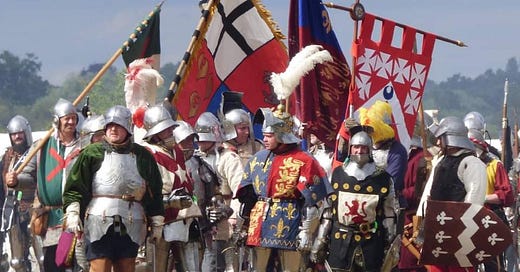March 1470, the battle of Lose-Coat or Loose-Coat Field, fought at Empingham in the county of Rutland, the East Midlands of England.
Here, Edward IV defeated a poorly organised rebel army led by Sir Robert Welles, a former Lancastrian. The real movers and shakers of the rebellion were the Earl of Warwick and the Duke of Clarence, the king's former allies, who had grown tired of Edward and wanted to replace him with someone better i.e. themselves.
To that end they stirred up a revolt among old Lancastrians, still smarting at the defeat and deposition of Henry VI. Sadly for them, things did not go Welle: after a brief exchange of cannon fire, the rebels broke and fled. This was after Edward had Welles' father, Lord Welles, executed in full view of both armies. Possibly the sight of his head falling off shattered rebel morale, or they didn't fancy engaging Edward's battle-hardened veterans.
Welles junior and his commander of foot, Richard Warren, were both captured and executed a few days afterwards. First Welles confessed his treason, and produced letters showing the complicity of Warwick and Clarence. As a result they were forced to flee the country.
The name of the battle derives from a story that the rebels threw away their livery jackets, displaying the arms of Warwick and Clarence, as they ran. However, this was first recorded in the 19th century, and has no contemporary basis.
According to Wikipedia, Lose-Coat may derive from the Old English hlose-cot, meaning Pigsty Cottage. So there we are. The Battle of Pigsty Cottage. Much better.
Attached is the only known photograph of the battle.
l



